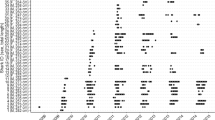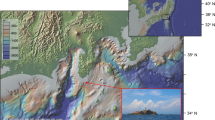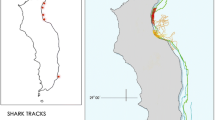Abstract
In the southwestern Gulf of California one of the most successful marine protected areas (MPA) worldwide is found: Cabo Pulmo National Park (CPNP). Due to the level of protection and availability of prey, a large population of bull sharks (Carcharhinus leucas) exists in this MPA. Historical records about the abundance and distribution of these sharks in the park are scarce. Here we describe the movement patterns of 32 bull sharks within CPNP using a passive acoustic telemetry array (N = 13) located along the park to examine how the residency of the species change spatially and temporally. Environmental variables were taken in situ (HOBOs) and complemented with satellite information (MODIS aqua). The mean residence index (RI) was 0.365 (SD ± 0.2143). Sharks were resident from December to May, whereas they were absent from August to October. Most bull sharks preferred water temperatures below 28 ºC and depths as shallow as 14 m as well as deeper waters ranging from 70 to 160 m. They thus occupy a wide range of habitats with diverse prey, from shallow to mesophotic reefs. Differences in the residency of males and females occur in response to temperature during the different seasons, resulting in sexual segregation. Our results suggest that females segregate from males probably for reproductive reasons (pupping in another area) or to feed on more energy-rich prey resulting in increased growth rates. This study provides information germane to the protection and management of bull sharks in CPNP.








Similar content being viewed by others
Data availability
Data supporting this work will be made available on reasonable request to the corresponding and senior authors of this manuscript.
References
Aburto-Oropeza O, Erisman B, Galland GR, Mascareñas-Osorio I, Sala E, Ezcurra E (2011) Large recovery of fish biomass in a no-take marine reserve. PLoS ONE 6:e23601. https://doi.org/10.1371/journal.pone.0023601
Ackerman JT, Kondratieff MC, Matern SA, Cech JJ (2000) Tidal influence on spatial dynamics of leopard sharks, Triakis semifasciata, in Tomales Bay, California. Environ Biol Fish 58:22–43. https://doi.org/10.1023/A:1007657019696
Acuña-Marrero D, Smith ANH, Salinas-de-Leon P, Harvey ES, Pawley MDM, Anderson MJ (2018) Spatial patterns of distribution and relative abundance of coastal shark species in the Galapagos Marine Reserve. Mar Ecol Progr Ser 593:73–95. https://doi.org/10.3354/meps12505
Alvarez-Filip L, Paddack MJ, Collen B, Robertson DR, Côté IM (2015) Simplification of Caribbean reef-fish assemblages over decades of coral reef degradation. PLoS ONE 10:e0126004. https://doi.org/10.1371/journal.pone.0126004
Ayres KA, Ketchum JT, González-Armas R, Galván-Magaña F, Hearn A, Elorriaga-Verplancken FR, Hoyos-Padilla EM, Kajiura SM (2021) The use of an unoccupied aerial vehicle to survey shark species over sand and rocky-reef habitats in a marine protected area. J Fish Biol 99:1735– 1740. https://doi.org/10.1111/jfb.14838
Bangley CW, Paramore L, Dedman S, Rulifson RA (2018) Delineation and mapping of coastal shark habitat within a shallow lagoonal estuary. PLoS ONE 13:e0195221. https://doi.org/10.1371/journal.pone.0195221
Bangley CW, Paramore L, Shiffman DS, Rulifson RA (2018) Increased abundance and nursery habitat use of the Bull Shark (Carcharhinus leucas) in response to a changing environment in a warm-temperate estuary. Sci Rep 8:9018. https://doi.org/10.1038/s41598-018-24510-z
Bascompte J, Melián CJ, Sala E (2005) Interaction strength combinations and the overfishing of a marine food web. Proc Natl Acad Sci 102:5443–5447
Branstetter S, Musick JA, Colvocoresses JA (1987) A comparison of the age and growth of the tiger shark (Galeocerdo cuvier), from off Virginia and from the northwetsern Gulf of Mexico. Fish Bull 85:269–279
Bruce BD, Stevens JD, Bradford RW (2005) Site fidelity, residence times and home range patterns of White Sharks around pinniped colonies. Final Report to the Department of Environment and Heritage. CSIRO Marine Research, Hobart, Tasmania, 41 pp.
Brunnschweiler JM, Queiroz N, Sims DW (2010) Oceans apart? short-term movements and behaviour of adult bull sharks Carcharhinus leucas in Atlantic and Pacific Oceans determined from pop-off satellite archival tagging. J Fish Biol 77:1343–1358. https://doi.org/10.1111/j.1095-8649.2010.02757.x
Brunnschweiler J M, Abrantes KG, Barnett A (2014) Long-term changes in species composition and relative abundances of sharks at a provisioning site. PLoS ONE 9(1). https://doi.org/10.1371/journal.pone.0086682
Brusca RC, Thomson DA (1975) Pulmo reef: the only “coral reef” in the Gulf of California. Cienc Mar 2:37–53
Carlson JK, Ribera MM, Conrath CL, Heupel MR, Burgess GH (2010) Habitat use and movement patterns of bull sharks Carcharhinus leucas determined using pop-up satellite archival tags. J Fish Biol 77:661–675. https://doi.org/10.1111/j.1095-8649.2010.02707.x
Chapman DDF, Pikitch EK, Babcock EA, Mumby PJ, Micheli F, Dahlgren CP, Litvin SY et al (2006) Marine parks need sharks? Science 312:526–528. https://doi.org/10.1126/science.312.5773.526d
Cliff G, Dudley SF (1991) Sharks caught in the protective gill nets off Natal, South Africa. 4. the Bull Shark Carcharhinus leucas Valenciennes. S Afr J Mar Sci 10:253–270. https://doi.org/10.2989/02577619109504636
Compagno LJV (1984) Sharks of the world: an annotated and illustrated catalogue of shark species known to date. Part 1: Hexanchiformes to Lamniformes. FAO Species Cataloque (Vol. 4), FAO Fisheries Synopsis No 125
Compagno LJV (2001) FAO species catalogue for fisheries purposes. Sharks of the world—an annotated and illustrated catalogue of shark species known to date. Food and Agriculture Organization of the United Nations, Rome
Curtis TH, Adams DH, Burgess GH (2011) Seasonal distribution and habitat associations of bull sharks in the Indian River Lagoon, Florida: a 30-year synthesis. Trans Am Fish Soc 140:1213–1226. https://doi.org/10.1080/00028487.2011.618352
Daly R, Smale MJ, Cowley PD, Froneman PW (2014) Residency patterns and migration dynamics of adult bull sharks (Carcharhinus leucas) on the East Coast of Southern Africa. PLoS ONE 9(10):e109357. https://doi.org/10.1371/journal.pone.0109357
Dudley SFJ, Cliff G (1993) Some effects of shark nets in the Natal nearshore environment. Environ Biol Fishes 36:243–255. https://doi.org/10.1007/BF00001720
Espinoza M, Cappo M, Heupel MR, Tobin AJ, Simpfendorfer CA (2014) Quantifying shark distribution patterns and species-habitat associations: implications of marine park zoning. PLoS ONE 9(9). https://doi.org/10.1371/journal.pone.0106885
Gallagher AJ, Hammerschlag N (2011) Global shark currency: the distribution frequency and economic value of shark ecotourism. Curr Issues Tour 14:797–812. https://doi.org/10.1080/13683500.2011.585227
Hammerschlag N, Luo J, Irschick DJ, Ault JS (2012) A comparison of spatial and movement patterns between sympatric predators: bull sharks (Carcharhinus leucas) and Atlantic tarpon (Megalops atlanticus). PLoS ONE 7(9): e45958. https://doi.org/10.1371/journal.pone.0045958
Hearn A, Ketchum JT, Klimley AP (2009) Vulnerability of top predators to climate change and adaptations for coastal and pelagic ecosystems: sharks a case study. In: Hoffman J, Fonseca A, Drews C (eds) Cetaceans & other marine biodiversity of the Eastern Tropical Pacific: options for adapting to climate change. Proceedings of Conference, Adaptación Cambio Climático, San Jose Costa Rica, pp 42–44
Hearn A, Ketchum J, Klimley AP, Espinoza E, Peñaherrera C (2010) Hotspots within hotspots? hammerhead shark movements around Wolf Island, Galapagos Marine Reserve. Mar Biol 157:1899–1915. https://doi.org/10.1007/s00227-010-1460-2
Heupel MR, Simpfendorfer CA (2007) Movement and distribution of young bull sharks Carcharhinus leucas in a variable estuarine environment. Aquat Biol 1:277–289. https://doi.org/10.3354/ab00030
Heupel MR, Simpfendorfer CA, Fitzpatrick R (2010) Large-scale movement and reef fidelity of grey reef sharks. PLoS ONE 5(3):e9650. https://doi.org/10.1371/journal.pone.0009650
Hoyos-Padilla ME, Ketchum JT, Klimley AP, Galván-Magaña F (2014) Ontogenetic migration of a female scalloped hammerhead shark Sphyrna lewini in the Gulf of California. Anim Biotelemetry 2:17. https://doi.org/10.1186/2050-3385-2-17
Karl SA, Castro ALF, Lopez JA, Charvet P, Burgess GH (2011) Phylogeography and conservation of the bull shark (Carcharhinus leucas) inferred from mitochondrial and microsatellite DNA. Conserv Genet 12:371–382. https://doi.org/10.1007/s10592-010-0145-1
Ketchum JT, Hearn A, Shillinger G, Espinoza E, Penaherrera C, Klimley AP (2009) Shark movements and the design of protected pelagic environments within and beyond the Galapagos Marine Reserve. In: Wolff, M., Gardener, M. (Eds.), Proceedings of the Galapagos Science Symposium. Charles Darwin Foundation, Puerto Ayora, pp. 127–130
Ketchum JT, Hearn A, Klimley AP, Espinoza E, Peñaherrera C, Largier JL (2014a) Seasonal changes in movements and habitat preferences of the scalloped hammerhead shark (Sphyrna lewini) while refuging near an oceanic island. Mar Biol 161:755–767. https://doi.org/10.1007/s00227-013-2375-5
Ketchum JT, Hearn A, Klimley AP, Peñaherrera C, Espinoza E, Bessudo S, Soler G, Randall Arauz R (2014b) Inter-island movements of scalloped hammerhead sharks (Sphyrna lewini) and seasonal connectivity in a marine protected area of the Eastern Tropical Pacific. Mar Biol 161:939–951. https://doi.org/10.1007/s00227-014-2393-y
Kimball M, Miller J, Whitfield P, Hare J (2004) Thermal tolerance and potential distribution of invasive lionfish (Pterois volitans) on the East Coast of the United States. Mar Ecol Prog Ser 283:269–278. https://doi.org/10.3354/meps283269
Klimley AP (1987) The determinants of sexual segregation in the scalloped hammerhead shark, Sphyrna lewini. Environ Biol Fish 18:27–40. https://doi.org/10.1007/BF00002325
Klimley AP (1993) Highly directional swimming by scalloped hammerhead sharks, Sphyrna lewini, and subsurface irradiance, temperature, bathymetry, and geomagnetic field. Mar Biol 117:1–22. https://doi.org/10.1007/BF00346421
Klimley AP, Butler SB (1988) Immigration and emigration of a pelagic fish assemblage to seamounts in the Gulf of California related to water mass movements using satellite imagery. Mar Ecol Prog Ser 49:11–20
Matich P, Heithaus MR, Layman CA (2011) Contrasting patterns of individual specialization and trophic coupling in two marine apex predators. J Anim Ecol 80:294–305. https://doi.org/10.1111/j.1365-2656.2010.01753.x
Mendiola ME (2015) Movements, habitat use and connectivity of reef-associated sharks: implications for management and conservation. James Cook University
Meyer CG., Papastamatiou YP, Holland KN (2010) A multiple instrument approach to quantifying the movement patterns and habitat use of tiger (Galeocerdo cuvier) and Galapagos sharks (Carcharhinus galapagensis) at French Frigate Shoals, Hawaii. Mar Biol 157:1857–1868. https://doi.org/10.1007/s00227-010-1457-x
Myers RA, Baum JK, Shepherd, TD, Powers, SP, Peterson, CH (2007) Cascading effects of the loss of apex predatory sharks from a coastal ocean. Science 315:1846–1850. https://doi.org/10.1126/science.1138657
Myers RA, Worm B (2005) Extinction, survival or recovery of large predatory fishes Philos. Trans R Soc Lond B, Biol Sci 360:13–20. https://doi.org/10.1098/rstb.2004.1573
Lara-Lizardi F, Hoyos-Padilla M, Ketchum JT, Galván-Magaña F (2018) Range expansion of the whitenose shark, Nasolamia velox, and migratory movements to the oceanic Revillagigedo Archipelago (west Mexico). J Mar Biolog Assoc UK 98:949–953
Lester EK, Langlois TJ, Simpson SD, McCormick MI, Meekan MG (2020) The hemisphere of fear: the presence of sharks influences the three dimensional behaviour of large mesopredators in a coral reef ecosystem. Oikos 129:731–739
Papastamatiou YP, Lowe CG, Caselle JE, Friedlander AM (2009) Scale-dependent effects of habitat on movements and path structure of reef sharks at a predator-dominated atoll. Ecology 90:996–1008. https://doi.org/10.1890/08-0491.1
Pasos-Acuña C, Almendarez-Hernández MA, Hoyos-Padilla EM, Blázquez M, Ketchum JT (2020) Economic valuation of diving with bull sharks in natural conditions: a recent activity in Cabo Pulmo National Park, Gulf of California, Mexico. In: Ortega-Rubio A (ed) Socio-ecological Studies in Natural Protected Areas. Springer, Cham, pp 485–509. https://doi.org/10.1007/978-3-030-47264-1_25
Payne NL, Meyer CG, Smith JA, Houghton JDR, Barnett A, Holmes BJ, Nakamura I et al (2018) Combining abundance and performance data reveals how temperature regulates coastal occurrences and activity of a roaming apex predator. Glob Change Biol 24:1–11. https://doi.org/10.1111/gcb.14088
Quintanilla S, Gómez A, Mariño-Ram C, Sorzano C, Bessudo S, Soler G, Bernal JE et al (2015) Conservation genetics of the scalloped hammerhead shark in the Pacific Coast of Colombia. J Hered 106:448–458. https://doi.org/10.5061/dryad.kq685
Reyes-Bonilla H, Ayala-Bocos A, Fernández-Rivera FJ, Melo A, Zepeta-Vilchis R, Asúnsolo-Rivera A, Ketchum JT (2016) A bibliographic and field record chronology of sharks at Cabo Pulmo National Park, Gulf of California. Oceánides 31:55–57
Rigby CL, Espinoza M, Derrick D, Pacoureau N, Dicken M (2021) Carcharhinus leucas. The IUCN Red List of Threatened Species 2021: e.T39372A2910670. https://doi.org/10.2305/IUCN.UK.2021-2.RLTS.T39372A2910670.en
Rizzari JR, Frisch AJ, Hoey AS, McCormick MI (2014) Not worth the risk: apex predators suppress herbivory on coral reefs. Oikos 123:829–836
Robbins RL (2007) Environmental variables affecting the sexual segregation of great white sharks Carcharodon carcharias at the Neptune Islands South Australia. J Fish Biol 70:1350–1364. https://doi.org/10.1111/j.1095-8649.2007.01414.x
Simons RA (2016) ERDAP. Monterey, CA: NOAA/NMFS/SWFSC/ERD
Simpfendorfer CA, Heupel MR (2012) Assessing habitat use and movement. In: Carrier JC, Musick, JA, Heithaus MR (eds), Biology of sharks and their relatives, CRC Press, pp 553–572. https://doi.org/10.1201/b11867-23
Simpfendorfer CA, Tobin AJ (2015) Contrasting movements and connectivity of reef-associated sharks using acoustic telemetry: implications for management. Ecol Appl 25:2101–2118. https://doi.org/10.1890/14-2293.1
Smoothey AF, Lee KA, Peddemors VM (2019) Long-term patterns of abundance, residency and movements of bull sharks (Carcharhinus leucas) in Sydney Harbour, Australia. Scientific Reports 9:18864. https://doi.org/10.1038/s41598-019-54365-x
Snelson FF, Mulligan TJ, Williams SE (1984) Food habits, occurrence, and population structure of the bull shark, Carcharhinus leucas, in Florida coastal lagoons. Bull Mar Sci 34:71–80
Steneck RS, Sala E (2005) Large marine carnivores: trophic cascades and top-down controls in coastal ecosystems past and present. In: Ray JC, Redford KH, Steneck RS, Berger J (eds) Large carnivores and the conservation of biodiversity. Island Press, Washington, pp 110–137
Stevens JD, Bonfil R, Dulvy NK, Walker PA (2000) The effects of fishing on sharks, rays, and chimaeras (chondrichthyans), and the implications for marine ecosystems. ICES J Mar Sci 57:476–494
Sundström LF, Gruber SH, Clermont SM, Correia JPS, De Marignac JRC, Morrissey JF, Lowrance CR, Thomassen L, Oliveira MT (2001) Review of elasmobranch behavioral studies using ultrasonic telemetry with special reference to the lemon shark, Negaprion brevirostris, around Bimini Islands, Bahamas. Environ Biol Fish 60:225–250. https://doi.org/10.1023/A:1007657505099
Trystram C, Rogers KM, Soria M, Jaquemet S (2016) Feeding patterns of two sympatric shark predators in coastal ecosystems of an oceanic island. Can J Fish Aquat Sci 74:1–34. https://doi.org/10.1139/cjfas-2016-0105
Valle-Rodríguez J, Trasviña-Castro A (2017) Poleward currents from coastal altimetry: the west coast of southern Baja California, Mexico. Adv Space Res 58:2313–2324. https://doi.org/10.1016/j.asr.2017.01.050
Vianna GMS, Meekan MG, Pannell DJ, Marsh SP, Meeuwig JJ (2012) Socio-economic value and community benefits from shark-diving tourism in Palau: a sustainable use of reef shark populations. Biol Conserv 145:267–277. https://doi.org/10.1016/j.biocon.2011.11.022
Ward-Paige CA, Britten GL, Bethea DM, Carlson JK (2015) Characterizing and predicting essential habitat features for juvenile coastal sharks. Mar Ecol 36:419–431. https://doi.org/10.1111/maec.12151
Werry JM, Lee SY, Lemckert CJ, Otway NM (2012) Natural or artificial? Habitat-use by the bull shark, Carcharhinus leucas. PLoS ONE 7:e49796. https://doi.org/10.1371/journal.pone.0049796
Werry JM, Sumpton W, Otway NM, Lee SY, Haig JA, Mayer DG (2018) Rainfall and sea surface temperature: key drivers for occurrence of bull shark, Carcharhinus leucas, in beach areas. Glob Ecol Conserv 15:e00430. https://doi.org/10.1016/j.gecco.2018.e00430
Whitney NM, Papastamatiou YP, Gleiss AC (2012a) Integrative multisensor tagging: emerging techniques to link elasmobranch behavior, physiology, and ecology. In: Carrier JC, Musick, JA, Heithaus MR (eds) Biology of sharks and their relatives, CRC Press. https://doi.org/10.1017/CBO9781107415324.004
Whitney NM, Robbins WD, Schultz JK, Bowen BW, Holland KN et al (2012b) Oceanic dispersal in a sedentary reef shark (Triaenodon obesus): genetic evidence for extensive connectivity without a pelagic larval stage. J Biogeogr. https://doi.org/10.1111/j.1365-2699.2011.02660.x
Wiley TR, Simpfendorfer CA (2007) The ecology of elasmobranchs occurring in the Everglades National Park, Florida: implications for conservation and management. Bull Mar Sci 80:171–189
Worm B, Davis B, Kettemer L, Ward-Paige CA, Chapman D, Heithaus MR, Kessel ST, Gruber SH (2013) Global catches, exploitation rates, and rebuilding options for sharks. Mar Policy 40:194–204. https://doi.org/10.1016/j.marpol.2012.12.034
Yeiser BG, Heupel MR, Simpfendorfer CA (2008) Occurrence, home range and movement patterns of juvenile bull (Carcharhinus leucas) and lemon (Negaprion brevirostris) sharks within a Florida estuary. Mar Freshw Res 59:489–501. https://doi.org/10.1071/mf07181
Zaitsev O, Trasviña-Castro A, Linero-Cueto J, Gaxiola-Castro G, Cepeda-Morales J (2014) Oceanographic conditions over the continental shelf off Magdalena Bay (Mexico) in 2011–2012. Cienc Mar 40:89–112
Acknowledgements
We thank the Paul Angell Foundation, International Community Foundation, Dalio Foundation, Alianza WWF-Fundación Carlos Slim, Alianza WWF-Fundación Telmex-Telcel, Mission Blue, Sherwood Scuba Marine Conservation, and Ocean Blue Tree for supporting our work. We also acknowledge CONANP and especially Carlos Gódinez, director of CPNP, and all of his staff for facilitating and providing all permits to be able to carry out this study. Many thanks to Manuel Castro, Alejandro Romero, and other members of the community for helping with the logistics to perform all the tagging and receiver maintenance activities. We are also grateful to Octavio Aburto and Tim Rowell of Scripps Institution of Oceanography for providing additional acoustic receivers that increased our array of listening stations in Cabo Pulmo.
Funding
Paul Angell Foundation, International Community Foundation, Dalio Foundation, Alianza WWF-Fundación Carlos Slim, Alianza WWF-Fundación Telmex-Telcel, Mission Blue, Sherwood Scuba Marine Conservation, Ocean Blue Tree.
Author information
Authors and Affiliations
Corresponding author
Ethics declarations
Ethics approval
Animal Care Protocols for the tagging of bull sharks were obtained from the University of California, Davis Institutional Animal Care and Use Committee (IACUC Protocol # 16022). The databases with acoustic tag detections are identified in the Methods section. All authors have read the manuscript, made editorial contributions, and are willing to be listed as authors on this paper.
Conflict of interest
The authors declare no competing interests.
Additional information
Publisher's note
Springer Nature remains neutral with regard to jurisdictional claims in published maps and institutional affiliations.
Rights and permissions
About this article
Cite this article
Lara-Lizardi, F., Hoyos-Padilla, E.M., Klimley, A.P. et al. Movement patterns and residency of bull sharks, Carcharhinus leucas, in a marine protected area of the Gulf of California. Environ Biol Fish 105, 1765–1779 (2022). https://doi.org/10.1007/s10641-022-01223-x
Received:
Accepted:
Published:
Issue Date:
DOI: https://doi.org/10.1007/s10641-022-01223-x




